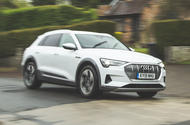The first electric Audi SUV aims to elevate the EV experience – will it make the right impression? We have three months to find out…
Why we’re running it: To see whether Audi has raised the bar for electric vehicles with its advanced Jaguar I-Pace rival
Month 1 – Specs

Here comes the ride, ravishing in white… and emissions free, too – 17th July 2019
The Audi E-tron’s limo-like qualities (and its brilliant white paint) made it an obvious choice for wedding car duties when a colleague’s daughter got married at Kew Gardens in south-west London recently – especially as a traditional horse and carriage wouldn’t have mixed very well with the required journey up the M3 motorway.
Come the big day, the bride couldn’t have been happier with her conveyance. The E-tron’s spacious interior coped easily with the sugar plum fairy dress, while the elevated seating position meant the bride made a serene, dignified entrance.
Just as impressively, the E-tron’s excellent refinement ensured the bride’s sister and father could effortlessly maintain a steady stream of reassuring chit-chat and therefore banish any lingering thoughts of a last-minute detour to the airport.
Like all electric vehicles, the E-tron has a regenerative braking system that uses the electric motors and brakes to harvest energy under deceleration and put it back into the battery pack, helping to eke out the range. The level of regen can be adjusted either automatically or manually via paddles behind the steering wheel, ranging from coasting with minimal drag through to strong enough to slow the car significantly when you lift off the accelerator. This can be a boon at times, especially around town, but in the E-tron’s case, it could be stronger.
In some EVs, such as the Nissan Leaf, the regen is so vigorous that you hardly ever have to touch the brake pedal. Audi suggests this is possible in the E-tron too, but I’m finding that even in its highest setting, the regen isn’t strong enough to bring the car to a halt without braking in the traditional manner. This, I assume, is to make the car behave in a way that drivers are used to from their previous non-electric cars, but you lose the benefit of full one-pedal driving in heavy traffic. I’m also finding it tricky to bring the E-tron to a halt without a lurch and creak if the ‘hold assist’ function is activated.

The indicated range has settled at around 220 miles with each full recharge, and it’s proving fairly trustworthy, with discrepancies of only about 10 miles either way between that figure and the distance the car can actually cover on a charge. And unlike in some smaller EVs, it doesn’t go into freefall at motorway speeds; the descent remains fairly linear. That’s been plenty for my needs so far, but sterner tests of its range – and more pertinently, its recharging times – are still to come.
On occasion, I’ve deliberately run the battery pack down to virtually empty, just to see how the car would respond. With 30 miles of indicated range remaining, a yellow battery symbol glows permanently in the digital instrument panel, accompanied by offers to find a convenient charging point. With just 10 miles’ range left, the battery symbol starts alternating with a little yellow tortoise symbol – a cute touch – and the car begins to cap power.
I got as low as two miles to go before I lost my nerve, at which point the power had been reduced to 25%, although the car still felt surprisingly perky, at town speeds at least.
Following the fault we encountered early on with the emergency call function, the adaptive cruise control – part of the £1950 Tour Pack option – has now made itself permanently unavailable for use. It was working well at first; in fact, its ability to adjust the car’s speed correctly, not just on congested motorways but also through speed limit changes and on dual-carriageway roundabouts and motorway slip roads, was quite mesmerising. I’ve cleaned the radar unit in the front bumper and other sensors, because often it’s just grime that causes a temporary outage, but the cruise control is still refusing to work. I’m still waiting to hear how that might be rectified.
Love it:
Zero emissions It’s good for my environmental conscience to know that, although I’m driving a massive luxury SUV, it emits precisely nothing.
Loathe it:
Home charging A full recharge takes a tedious 28 hours to full via my weedy 3kW wall box. I foresee a need for stops at motorway rapid chargers…
Mileage: 2455
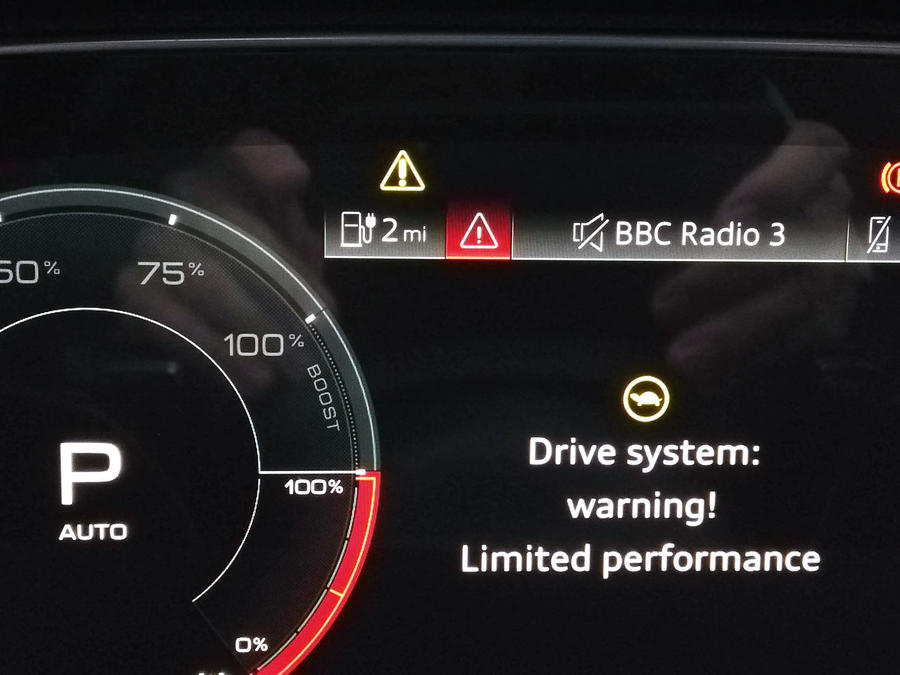
Life with an Audi E-tron: Month 1
An unexpected error message so soon – 26th June 2019
A week or so after the E-tron arrived, a warning message popped up saying there was a fault with the emergency call system, which sends for help if you have an accident. The car spent a couple of days in an Audi workshop while the fault was resolved (via a software update) free of charge. Online forums suggest other Audi models have had similar glitches.
Mileage: 2170
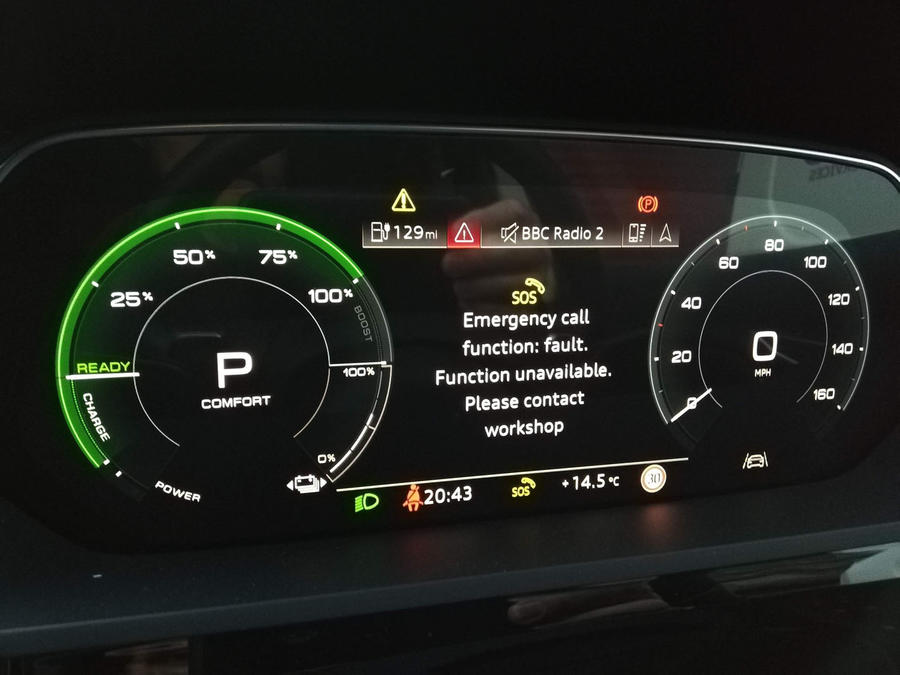
Luxurious EV has less range than rivals. Will that matter in daily use? We intend to see – 19th June 2019
The puzzled looks on the faces of passers-by are already a common sight. What they can see is yet another big Audi SUV. But what they can hear is… virtually nothing.
The usual clamour of an internal combustion engine – often diesel – is conspicuous by its absence as this imposing SUV glides past, and people notice, around town at least. As Audi’s first fully electric vehicle, the E-tron is at once reassuringly familiar and quite different from any previous model by the German brand.
Audi’s inaugural foray into the fast-growing EV market takes the form of a £70,000-plus luxury SUV to take on the Jaguar I-Pace and Tesla Model X, as well as the just-launched Mercedes-Benz EQC.
At 4.9m long, it’s closer in size to the Q7 than the Q5 and in fact shares some of its underpinnings with the Q7, including standard adaptive air suspension, although it’s lower and sleeker than both and is a five-seater only.
Two electric motors – one on each axle to give four-wheel drive – produce solid peaks of 402bhp and 490lb ft of torque, giving the E-tron forceful, Bentley-like performance (0-62mph in 5.7sec), despite the fact that the car weighs two and a half tonnes. The motors receive energy from a 95kWh battery pack that yields an official WLTP range of 241 miles. Considering the size of the battery pack, that’s a little underwhelming in comparison with the EQC’s 259 miles, the I-Pace’s 292 miles and the recently updated Model X Long Range’s 315 miles.
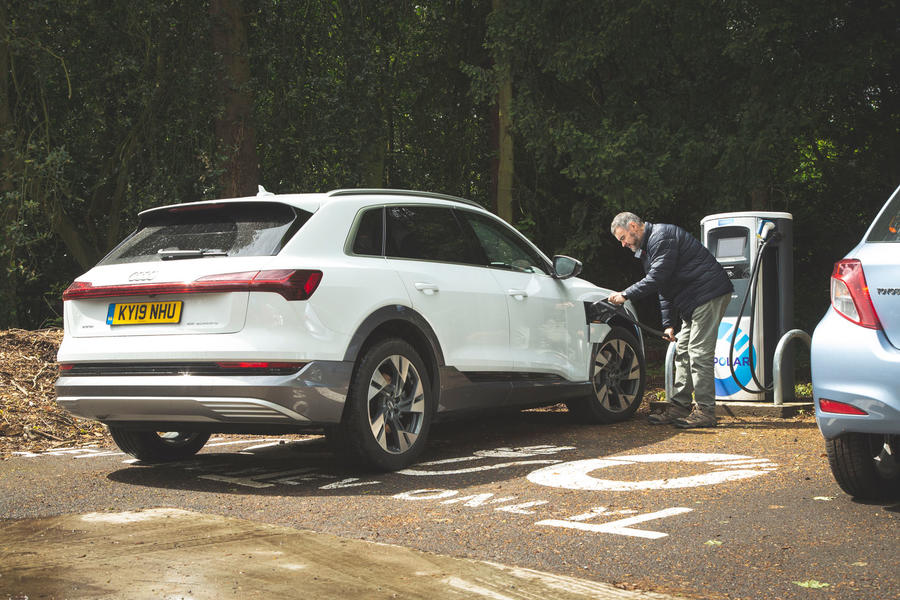
Autocar sibling magazine What Car? has already put the E-tron through its Real Range test and discovered that it can cover 196 miles between charges in real-world driving. That’s not bad, and I’m confident that I can improve on that figure by 20 or 30 miles. But it still means the E-tron is unlikely to go as far on a charge as any of its rivals, or indeed the smaller and much cheaper Kia e-Niro.
Recharging the battery pack isn’t a quick job, either, despite the fact that the E-tron can handle a charging rate of up to 150kW – one of the fastest of the current EVs on the market. A 0-80% recharge using a 50kW rapid charger – now readily available at most motorway services – will take about 90 minutes, and a 7kW home wallbox will do the job in 14 hours.
Best-case scenario is a 30-minute wait if I use one of the latest high-power public chargers, although they’re still few and far between in the UK, while the other extreme is more than 30 hours for a full top-up if I plug in at home, via a three-pin plug or the weedy 3kW wallbox (all I was allowed) that I had installed in my garage last year. Those times will come down, of course, if I plug the car in for a top-up well before the battery pack is fully depleted.
The E-tron is the only EV I’ve come across so far to have two charging ports: Type 2 seven-pin sockets on both sides and a European-standard CCS port for DC rapid charging on the driver’s side. That should make things easier at awkwardly located or busy charging stations. And the way the flaps motor down at the touch of a button and close automatically when you remove the charging cable is, I must admit, very swish, emphasising the quality of this car.
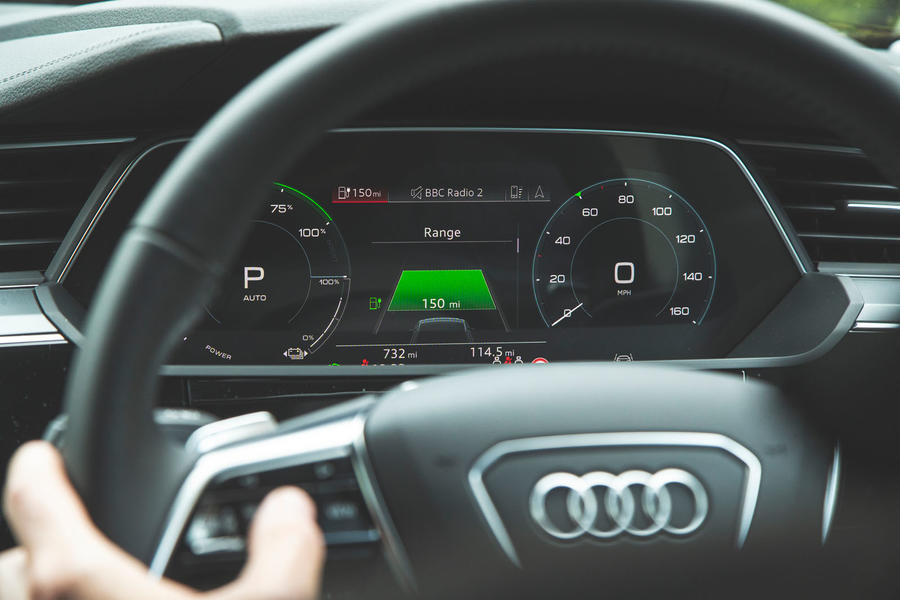
My E-tron isn’t the fully loaded Launch Edition, but even the regular one is classy and luxurious inside, with a configurable digital instrument panel and a pair of sharp, responsive, central touchscreens for the infotainment and secondary functions such as the climate control.
Although the interior is very high-tech, it’s remarkably close to what you’d find in any other recent high-end Audi, so there’s nothing too intimidating about it. Having said that, I haven’t seen a gear selector like the E-tron’s before. It’s a smooth, flat slab of metal that you operate with your fingertips and thumb.
Surprisingly, you have to add the £1950 Tour Pack (which we’ve done) to get extra driver aids such as adaptive cruise control, lane-keeping assistance, traffic sign recognition and other collision avoidance systems. Our car has conventional door mirrors rather than the optional camera-based alternatives (sadly) and differs slightly from UK spec in that it has, as individual options, an advanced key for high-security keyless entry (normally part of the £1895 Comfort and Sound Pack) and super-clear Audi Beam LED puddle lights (otherwise available on the Launch Edition only).
Despite the question mark over its efficiency, the E-tron is such an interesting and significant car that I consider myself lucky to be running one. I can already say with confidence that it’s one of the smoothest, quietest and plushest-riding cars I’ve driven, aided by the optional double-glazed side windows we’ve got on our car.
And If I’m going to run a luxury SUV, I’m glad it’s an electric one that doesn’t put out any CO2 or pollutants and will save me a fortune in fuel bills. The fact that the E-tron seemingly won’t go as far on a charge as its rivals might not matter when all of its other qualities are taken into account. This isn’t just any electric car, after all. It’s an electric Audi.
Second Opinion
After a succession of EVs that have been deliberately different and all too keen to shout about being battery powered, the E-tron is refreshingly normal. It’s a luxury car first and an electric one second, fitting right in with the rest of Audi’s range – but, given the price, it’ll be interesting to see if this subtlety is so endearing at the end the test.
Tom Morgan
Audi E-tron 55 quattro specification
Specs: Price New £68,020 (after £3500 government grant) Price as tested £74,725 OptionsTour Pack £1950, advanced key £850, four-zone deluxe automatic climate control £825, Glacier White metallic paint £750, acoustic side window glazing £525, rear side airbags and illuminated seatbelt buckles £475, privacy glass £475, aluminium roof rails £425, Audi Music Interface rear £175, Audi Beam £150, Storage and Luggage Pack £125
Test Data: Engine Two asynchronous electric motors Power 402bhp (in Boost mode) Torque 490lb ft (in Boost mode) Kerb weight 2490kg Top speed 124mph 0-62mph 5.7sec Range 241 miles (WLTP) CO2 0g/km Faults None Expenses None
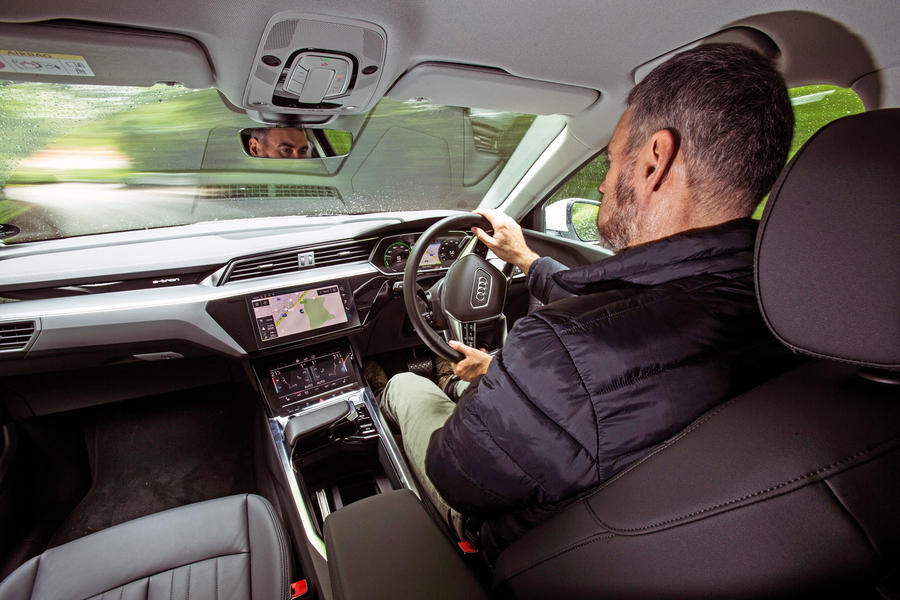
Source: Autocar
